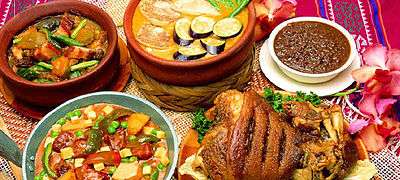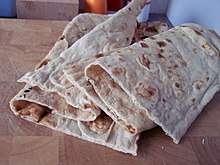Kabkab
Kabkab, also known as cassava cracker or cassava crisp, is a traditional Filipino disc-shaped wafer made from ground cassava. It originates from the southern Philippines, but is most closely associated with the cuisine of Mindanao and the southern Visayas Islands.[1]
| Alternative names | Cassava crackers, Cassava crisps, Salvaro, Cabcab, Sitsarit, Saritsit, Kiping, Burikit, Piking |
|---|---|
| Course | Dessert |
| Place of origin | Philippines |
| Main ingredients | cassava, latik |
Other names
Kabkab is the name of the dish in most of the southern Visayas. It is also known as salvaro in Cebu; kiping in Northern Mindanao, Camiguin, and Zamboanga del Norte; burikit in Dipolog City and Zamboanga del Sur; piking in Palawan; and sitsarit or saritsit in Davao City and Davao del Sur.[2][3][4]
Description
Kabkab is made from finely mashed cassava tubers with a little salt and sugar. It is slathered thinly on banana leaves and steamed until the cassava pulp becomes translucent and paste-like. It is then air-dried or sun-dried until it becomes crisp and rigid. It can be stored for long periods in this form, up to several months. Before consumption, kabkab must be deep-fried until it becomes golden in color. It is usually eaten as a dessert, with a swirl of latik (coconut caramel) on top; but it can also be eaten with savory dips and salsas.[2][3]
Similar dishes
Kiping is also the name for a similar rice-based wafer from Lucban, Quezon.[2]
See also
References
- "How to make Salvaro (Cassava Crisp)". Atbp.ph. Retrieved 26 March 2019.
- Polistico, Edgie. "kabkab". Philippine Food Illustrated. Retrieved 26 March 2019.
- "Cab-Cab or Cassava Crackers". Market Manila. Retrieved 26 March 2019.
- "Salvaro". Discover Cebu!. Retrieved 26 March 2019.

